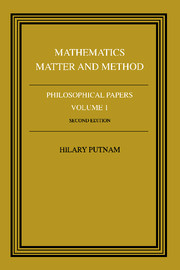Book contents
- Frontmatter
- Contents
- Dedication
- Introduction
- 1 Truth and necessity in mathematics
- 2 The thesis that mathematics is logic
- 3 Mathematics without foundations
- 4 What is mathematical truth?
- 5 Philosophy of physics
- 6 An examination of Grünbaum's philosophy of geometry
- 7 A philosopher looks at quantum mechanics
- 8 Discussion: comments on comments on comments: a reply to Margenau and Wigner
- 9 Three-valued logic
- 10 The logic of quantum mechanics
- 11 Time and physical geometry
- 12 Memo on ‘conventionalism’
- 13 What theories are not
- 14 Craig's theorem
- 15 It ain't necessarily so
- 16 The ‘corroboration’ of theories
- 17 ‘Degree of confirmation’ and inductive logic
- 18 Probability and confirmation
- 19 On properties
- 20 Philosophy of Logic
- Bibliography
- Index
11 - Time and physical geometry
Published online by Cambridge University Press: 04 August 2010
- Frontmatter
- Contents
- Dedication
- Introduction
- 1 Truth and necessity in mathematics
- 2 The thesis that mathematics is logic
- 3 Mathematics without foundations
- 4 What is mathematical truth?
- 5 Philosophy of physics
- 6 An examination of Grünbaum's philosophy of geometry
- 7 A philosopher looks at quantum mechanics
- 8 Discussion: comments on comments on comments: a reply to Margenau and Wigner
- 9 Three-valued logic
- 10 The logic of quantum mechanics
- 11 Time and physical geometry
- 12 Memo on ‘conventionalism’
- 13 What theories are not
- 14 Craig's theorem
- 15 It ain't necessarily so
- 16 The ‘corroboration’ of theories
- 17 ‘Degree of confirmation’ and inductive logic
- 18 Probability and confirmation
- 19 On properties
- 20 Philosophy of Logic
- Bibliography
- Index
Summary
I think that if we attempted to set out the ‘man on the street's’ view of the nature of time, we would find that the main principle underlying his convictions on this subject might be stated somewhat as follows:
(1) All (and only) things that exist now are real.
Future things (which do not already exist) are not real (on this view); although, of course they will be real when the appropriate time has come to be the present time. Similarly, past things (which have ceased to exist) are not real, although they were real in the past.
Obviously, we shall have to make some assumptions about the concept real if we are to discuss the ‘man on the street's’ view at all. The assumptions I shall make are as follows:
I. I-now am real. (Of course, this assumption changes each time I announce that I am making it, since ‘I-now’ refers to a different instantaneous ‘me’.)
II. At least one other observer is real, and it is possible for this other observer to be in motion relative to me.
And, the most important assumption, which will be referred to (when properly understood) as the principle that There Are No Privileged Observers:
III. If it is the case that all and only the things that stand in a certain relation R to me-now are real, and you-now are also real, then it is also the case that all and only the things that stand in the relation R to you-now are real.
- Type
- Chapter
- Information
- Mathematics, Matter and MethodPhilosophical Papers, pp. 198 - 205Publisher: Cambridge University PressPrint publication year: 1979
- 2
- Cited by



